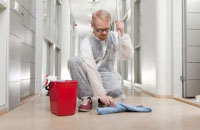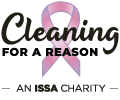Articles
Terrazzo Floors: Making a Comeback
Categories: Cleaning Best Practices, Innovations, Trends & Technology
By Debby Davis | October 9, 2018 << Back to Articles
Many cleaning contractors, distributors, and facility managers may not realize it, but a flooring material that dates back to the 1400s, is making a big comeback. Terrazzo is not only increasingly used for floors in both commercial and residential settings, but it is also used to make countertops, partitions, and even bathtubs and to cover walls.
Back in the 1400s, terrazzo, which comes from the Italian word for terrace, was discovered almost by accident when crushed marble, glass, clay, and other materials were mixed with goat milk (as the sealer). Once dried, polished, and honed, the material proved to be surprisingly attractive and was soon used for a variety of purposes, from flooring to anchoring statues and art objects.
Shortly thereafter, terrazzo became popular as a status symbol and flooring choice for kings and queens. While it originally was viewed as a low-cost flooring material, as it was refined, tasks such as preparing, grinding, cleaning, and polishing took a considerable amount of time and added to terrazzo’s overall cost. Over the years, and even in some cases today, terrazzo can be more expensive than many other flooring materials, including marble and granite.
Durability
It cannot be denied that terrazzo’s durability has added to its popularity over the centuries. Original terrazzo floors are commonly found in buildings that are hundreds of years old. In fact, some of the terrazzo floors installed in George Washington’s Mount Vernon home (built in the mid-1700s) are still in service today. However, while terrazzo is very durable, the material certainly is not impenetrable.
Terrazzo floors, particularly in a commercial setting such as office buildings or schools, are susceptible to spills from soda, fruit juices, coffee, and other liquids, which actually can penetrate the surface. These liquids can leave stains, especially if the floor has not been sealed or finished.
Other enemies of terrazzo—similar to many flooring materials—are grit, dust, and sand. With foot traffic, grit can grind into the terrazzo, leaving what are essentially tiny potholes, cuts, and scratches that can be difficult to repair using traditional cleaning methods. When this happens, cleaning professionals must scrub the floor clean, apply a sealant or finish, and then buff or burnish. While this may help cover up the problem, the situation could be avoided if a sealant or finish is applied properly in the first place.
Basic Terrazzo Care
Before delving into the offerings found in the floor sealant and finish markets, we first must cover some basics. Basic care of terrazzo floors starts with the installation of an effective matting system, especially if the terrazzo has been installed at building entries. Mats can help trap sand and grit before these contaminants have a chance to impact terrazzo surfaces.
The floor should also be regularly swept, mopped, or vacuumed. In some busier facilities, this cleaning is performed throughout the day. Additionally, all spills should be cleaned as quickly as possible so they do not have a chance to penetrate or stain the floor.
When mopping, cleaning professionals are advised to use a neutral floor cleaner and change the mop head and cleaning solution frequently. Research shows that as a traditional mop is used, it can become soiled and contaminated, spreading contamination on the floor and defeating the purpose of cleaning. If flooring has been sealed or finished and a soiled mop and contaminated water are used, it can result in hazing or streaking, which can mar the appearance of the floor.
In many cases, it may be helpful to use a bucket system that releases measured amounts of solution directly to the floor without the use of a mop. With this method, fresh cleaning solution is applied to the floor, helping to minimize the spread of contamination.
Turning to Automatic Scrubbers
Cleaning and mopping are most effective in smaller floor areas where terrazzo has been installed or in congested areas that may need to be cleaned manually. However, often the fastest way to clean terrazzo floors is with an automatic scrubber.
An automatic scrubber vacuums, cleans, and dries the floor all in one pass. There are many auto scrubbers available, but cleaning professionals will have more flexibility and maneuverability, as well as fewer safety issues, when a battery-operated machine is used. Long cords stretched over floor areas can be an accident waiting to happen.
Some battery operated machines can now go several hours without a recharge, improving worker productivity. Additionally, productivity is enhanced if the right sized machine is selected. If the machine is too small, it can take too long to clean the floor. Choose too large a scrubber and it may not be able to clean in tight or congested areas, which means these areas may have to be cleaned manually, slowing down the entire cleaning process.
The Shine
While a sealant will not necessarily put a shine on the floor; it will help protect the floor from damage. A finish will add a luster to terrazzo flooring. Facility managers and cleaning professionals must determine the appropriate level of gloss for their facilities. Finishes designed to be used with a high-speed burnisher typically result in a high-gloss, wet-look shine.
Today’s terrazzo floors are made differently than those made and installed centuries ago. The actual flooring is thinner and it is poured into slabs and then installed. The process produces a lighter floor that is more impervious to cracks. Additionally, modern manufacturing methods also make it possible to offer terrazzo in a variety of colors. We do not know whether these terrazzo floors will last centuries, but we do know that terrazzo is back in style and can be relatively easy to maintain with proper know-how and care.
About the Author.
Debby Davis, an industry veteran who is well-versed on floor care issues, is product manager for Powr-Flite, a manufacturer of professional cleaning equipment. She may be reached via her company website at www.powr-flite.com.





